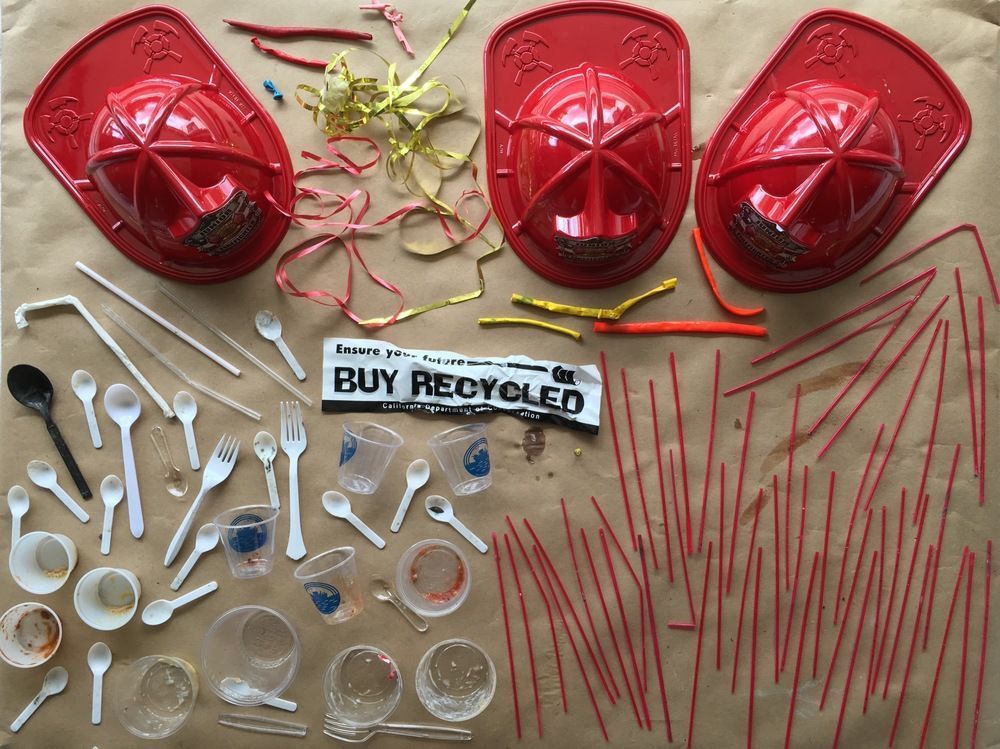There is no away is one of our favorite blogs. Heather Itzla started collecting plastic that she founded while walking her two dogs in San Anselmo and Fairfax, California. She takes pictures of all that she finds and post on her blog to raise awareness about plastic pollution. We love the fact that a routine like walking your dogs can be turned into a solidary action with our planet. And of course, we love her pictures, they look like as if they were taken on archeological sites.
And we love the passion, positivity and generosity that Heather transmits. We need more people like her in this world!
 Can you please tell us a little bit about yourself and how you started blogging about the environmental impacts of single use plastics?
Can you please tell us a little bit about yourself and how you started blogging about the environmental impacts of single use plastics?
Early in 2013 I stumbled across Captain Charles Moore’s Ted Talk “Seas of Plastic” It changes the course of my life – I’m so stunned by what he says, I become obsessed with learning everything I can about plastic pollution. Once I became aware of the problem, I started noticing bits of plastic everywhere I went. At first I just photograph the pieces as I come across them on the ground, and I dispose of them back at home. Then I find that I am picking up so much on every walk, I start to photograph the pieces together back at my house.
When was the first photo taken?
May 2013
We have counted more than 310 photos in your blog. It is incredible the amount of trash that you have picked up. Imagine if you could take a photo of all this plastic together. It would be a huge plastic mountain! This seems to be a hard job. How do you stay motivated after all this time?
Actually, I have something like 600 photos of the trash I collected on walks! I have wondered what it would look like in one giant heap, or how much it would weigh! I can’t imagine taking a walk and not picking up plastic – I’ll do it for the rest of my life because every piece I pick up is a piece that won’t be in the belly of an albatross, sea turtle, or whale. I wish I could pick up more!
“There is no away” is not only about picking up plastic and taking photos to raise awareness. There You have are several projects going on. Can you explain to us how all this developed, from taking photos to these projects.
I see so many simple ways to reduce the amount of plastic we use every day –once you realize what the problem is, you see so clearly how to reduce it – Plastic has slowly and quietly been worked into almost every single product we use/consume – Stand in a store and slowly look around to find anything that isn’t either plastic or wrapped in plastic – good luck. I wish there were more hours in the day to work on projects to help people connect with alternatives to plastic because once you help people see the problem and how they can help, it opens their eyes and minds and the message spreads from them to their friends and families. The topic is slowly beginning to get much needed press and attention (not nearly fast enough for me!).
The Straw Project came about because I learned that 500 million straws are used in the U.S. every day – I began putting aside all of the straws I found on the ground in my town in order to show what we were contributing to the problem of straws washing down storm drains and out to the bay. From there I connected with a group of High School students in need of an environmental project for school, and we worked together to approach restaurant owners with the idea of only giving straws to customers that request them.
 We started trying to live plastic-free for a couple of months and then we went to the beach for holidays and it just seemed natural to pick up the plastic we found on the shore. In your case what came first, picking up the plastic you found or avoiding plastic in your daily life?
We started trying to live plastic-free for a couple of months and then we went to the beach for holidays and it just seemed natural to pick up the plastic we found on the shore. In your case what came first, picking up the plastic you found or avoiding plastic in your daily life?
There is still quite a lot of plastic in my life! I have two teenage sons, so I can only control so much!
I take my own glass jars (for oils, nuts, flour, coffee beans) to the grocery store, we only use glass or stainless straws, we have our own bamboo cutlery for to- go orders, and we just refuse unnecessary plastic whenever and wherever we can.
We use plastic bread bags or chip bags to start a “plastic bag” under the sink next to the rest of the recycling – in there we put all of the little stray pieces of plastic (clothing tags, wrappers,) so that at the end of the week it is a dense wad of plastic (like a football) that I seal with masking tape – this makes up the bulk of what we send to the landfill. I do this because I know that a large amount of the plastic I pick up off of the streets every day is there because it fell out of the garbage can when it was tipped into the garbage truck – because it wasn’t tightly secured, it spilled out.
I’m incredibly impressed by people that are “plastic free”, but I think I can have my greatest impact by working on projects that keep as much plastic from coming into the hands/homes of as many people as I can reach, than I could have by keeping 100% of plastic out of my own home.
Sometimes we think that is very difficult to approach people, that they are not going to be interested in our projects or in the environment. However, your projects are working very well. How do you approach people to encourage them to get involved in these projects?
I try to keep my messages positive (there’s plenty of bad news and depressing statistics already) It’s easier to make changes in a positive, supportive environment, plus it’s more fun. I also make fun of myself and readily expose my shortcomings in hopes that people find me relatable – I’m far from perfect (whatever that is), and before I knew about the problem, I was using as much plastic as everyone else!
One of my favorite ways to get people involved is the Plastic Raffle. I get a few great prizes (I think it is best if they are products that help people reduce plastic in their lives – Glass Straws are my favorite prize, but I’ve also used non-plastic reusable lunch boxes, bamboo cutlery…) – And you tell kids that they can have a free raffle ticket in Exchange for a piece of plastic they found on the ground – People are surprised that you aren’t asking for money, and they think it is weird to give you a dirty Straw, or a Candy wrapper – but it is a beautiful moment to have a conversation about why it is important to get that plastic off of the Street (so it doesn’t wash down the gutter and out to sea!) It is helpful to have photos that show what the problem is – I’ve also given out raffle tickets to people that stop to answer a question like “how many tons of plastic would you guess enters the ocean every year/day/hour/minute/second” People are always astounded and I’ve only ever had great interactions.
 What do you think is the best advice we can give in order to avoid the negative impacts of this single use plastic culture?
What do you think is the best advice we can give in order to avoid the negative impacts of this single use plastic culture?
Give people awareness – and then give them alternatives (it helps if you can make it beautiful/visually appealing – use Pinterest to find beautiful photos!) –BE HUMBLE AND KIND (no one likes to be forced to change – you have to lead them to this better way gently, with a smile on your face).
Educate the children – they can teach their parents a lot! Teach them to use paper pom poms instead of balloons (once they learn that balloons and plastic string kills countless sea creatures, they won’t like them so much anymore – THEY can tell their parents they don’t want them!).
What are the future plans for “There is not away”? Do you have any more projects in mind? What would you like to achieve in the next few years?
There is No Away is now sponsored as a non-profit and I have my very own intern starting next week!
I am working with Plastic Pollution Coalition on efforts to reduce/eliminate plastic in schools, starting with school supplies.
In a few years I would like to have a mobile Zero Waste caravan I take on the road in order to engage with as many people and communities as I can (lots of raffles!!). If we get enough pockets of great people making changes in their lives to connect across the globe, we’re going to do great things – Look at our conversation! Lovely people in Spain talking via the internet to someone in California about how to tackle this problem! This is the key to getting ahead of the problem!
Bonus questions:
What is the weirdest plastic item that you have found during your walks?
Hmmm, probably the bags of marijuana – seriously, quite a few, plastic tampón applicators, and the ironic stuff like plastic “save the earth” buttons! I’m going to make a bunch of buttons that say “No More Buttons!” (no I’m not).
Are you ever able to go for a stroll without thinking about collecting plastic or to return home empty-handed?
I have had to “look away” on the few occasions that I’m “dressed up” and out for a special evening – but other than those rare occasions NO – I’ll be looking down for plastic for the rest of my days!
If you’d like to know more about Heather, here you can see an interview from last year.
You can find this interview translated in Spanish here.


